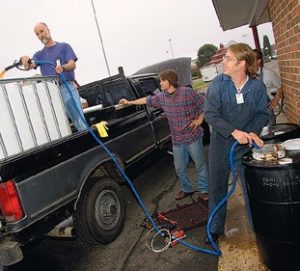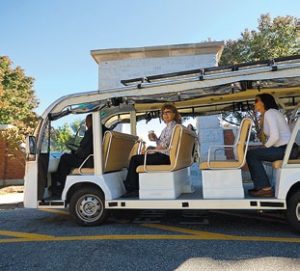Jeffrey P. Chamberlain (’88) heads the Electrochemical Energy Storage Department at Argonne National Laboratory, owned by the U.S. Department of Energy outside Chicago. A former Wake Forest Reynolds Scholar, he is the catalyst behind an electric battery blitz aimed at reducing our automobile-loving nation’s dependency on petroleum. Keenly aware of the environmental, economic and political stakes in the global competition to develop an efficient, affordable product, Chamberlain and his research team are focusing on lithium-ion technology. He accepted an invitation to speak as a guest lecturer in January in the Department of Chemistry Seminar Series about the potential for scientific research to impact the course of humanity.
The race — some have described it as “battery wars” — is on. What are you and your research team doing to keep the United States in the competition?
Argonne is a multipurpose national lab that’s a little bit of an odd beast — government-owned by the Department of Energy (DOE) but contractor-operated by a small company owned primarily by the University of Chicago since World War II. When Enrico Fermi and team were learning how to split the atom and have a controlled nuclear reaction they were doing it underneath a squash court in the suburbs of Chicago.
At Argonne our work in the Chemical Sciences and Engineering division focuses on peacetime use — nuclear science to create electricity. We have a transportation research center where about 100 scientists work on reduction of fossil fuel usage. We do all the research and also have facilities used by scientists around the world to advance a variety of scientific fields.
We are working to understand the nature of materials that store and release energy electrochemically. With that understanding, we design and invent new materials that can be used in batteries. Our work is primarily aimed at transportation applications; hybrid electric vehicles (HEVs), plug-in hybrid electric vehicles (PHEVs) and battery electric vehicles (BEVs) all rely on advanced batteries that hold enough energy, are powerful enough, safe enough and inexpensive enough to compete with gasoline-powered internal combustion engines.
The materials science not only focuses on developing new compositions, but also on new structures. Our materials research is complemented by several other research thrusts, including: a) diagnostics and analysis of material degradation during use in batteries, b) testing of a wide variety of advanced battery systems from around the world, c) computational science that predicts behaviors of new materials, and predicts behaviors and costs of entire battery systems and d) engineering science required to determine the optimal way to impactfully scale materials from the lab bench to kilogram quantities.

Jeff Chamberlain (left) explains Argonne’s research in advanced battery materials to Deputy Secretary of Energy Daniel B. Poneman.
Could you explain lithium-ion technology to a nonscientist?
When you burn fossil fuel all it is is a chemical reaction. You’re breaking bonds and the result is gases come out. For 100 years we utilized that for transportation and many things. We figured out how to use it to drive pistons and ultimately turn wheels on cars. When you move to electricity, if you have a battery in your phone or computer or car you’re still relying on a chemical reaction — with two differences. The electric battery spits out an electron instead of heat or gas, and you can capture that in the form of power. Another important difference is that it’s a reversible reaction. You can recharge your phone, computer or car and put those electrons back in. It’s a sustainable technology.
Lithium-ion technology was commercialized in 1991 by Sony; DOE had the foresight to have us start working on that thinking it would have a huge impact on transportation. Batteries that were used in previous attempts to electrify vehicles were too large and heavy. This technology uses lithium, the third lightest atom. If you can use a reactant that’s light and small and get an electron on every atom, you can pack more energy into that device. The result is a device that weighs one tenth of another and produces the same number of electrons. We work on materials that enable that ion to be transported less expensively, more safely. Argonne’s technology offers at least a 50 percent increase in energy storage capacity over conventional cathode materials used in lithium-ion batteries. In short, it offers among the longest-lasting energy available in the smallest, lightest package.
 What are the stakes in this “battery war”?
What are the stakes in this “battery war”?
It’s one of those hidden battles that will have an enormous impact on our economy, culture and, I argue, our freedom. In the spring of this year the United States exported $1 billion every day to import energy in the form of petroleum. Not all of that is to unfriendly people but a lot of it is. The economic recovery act under President Obama was just shy of $800 billion; another frame of reference is that we spent $180 billion in Afghanistan. What’s not in the media is what we spend per year outside of our borders. Imagine if we didn’t.
You begin to see how we can become dependent on energy we create here. That’s why we work on what we work on. The reason I’m motivated in this job is because this project is bigger than myself. Most scientists I know dream about this kind of project that has real, long-term impact on society. At its very basis, what we are trying to do is displace petroleum.
The scientific research we perform is funded by the DOE, and is aimed at supporting and enabling the automotive manufacturing base in the United States. As the auto manufacturers move more and more toward electric and hybrid electric vehicles, the USA becomes less and less dependent on foreign sources of energy to satisfy our transportation needs. What’s at stake, then, is energy security for the citizens of the United States.
Secondly, the lithium-ion battery market has already grown to be worth over $10 billion per year in terms of batteries sold. Almost all of this market is currently made up of batteries used in electronics applications (cellphones, laptop computers, power tools, etc.), and almost all of the manufacturing of this technology is done in Japan, Korea and China. As the electric vehicle market emerges in the coming years and decades, the advanced battery market (combined with the associated materials supplied into the battery market) will likely increase steadily to be worth over $100 billion dollars in annual sales revenues and requires employment of many thousands of people in production facilities. These figures do not include the wealth that will be generated by manufacturing and selling the vehicles that contain the advanced batteries.
Right now, in Japan, Korea and China, businesses like Panasonic, LG Chemical and Lishen, as well as Toyota and Honda, Hyundai and BYD, are all racing to be first to develop the best automotive technology so that they can own a large share of the market and jobs associated with the market. Thankfully, companies in the U.S. like Johnson Controls, GM and Ford are also engaged in that race. Our role at Argonne and in the other national laboratories and universities is to perform the scientific research that delivers the breakthroughs in fundamental understanding that companies will be able to use to help the USA win this race.
Finally, there is the well-understood issue of the various environmental impacts of using fossil fuels to power our vehicles on the road. If we succeed in our research, not only does our dependence on foreign sources of fossil fuel decrease, but our dependence and use of fossil fuels overall decreases.
Once a better battery is available and affordable, will this be a change people can’t resist or will it require “persuasion”?
Being a capitalist at heart, I believe the answer to this question is that, if we do our job right, ordinary marketing of the technology will suffice. Meaning, for an electric car to penetrate the market substantially, the product needs to perform as well as an ordinary car and be cost-competitive to own (a combination of purchase price and usage cost). Initially, there will likely be an “early adopter” market, driven by environmentally conscious consumers and technofiles, but, for full market penetration, the technology must be cost and performance-competitive with existing technology.
Do you foresee a time when electric cars outnumber those powered by gasoline?
Yes, there will be a time when electric cars or hybrids will outnumber purely gasoline-powered cars. However, I will not predict the date when that will happen … Getting back to the question of “what’s at stake,” if a mere 5 percent of vehicles sold annually are PHEVs or BEVs, the gross domestic product associated with that level of penetration will easily be in the tens of billions of dollars. So, it’s not so much an immediate issue of when there will be majority electrics — this kind of number is why every automaker in the world is developing an electric or hybrid electric car, because the value even at low penetration is enormous.
When reflecting on your years at Wake Forest you said, “Look what the Mother can do.” How did your alma mater inspire and prepare you to take on an important challenge?
I give great credit and thanks to Wake Forest for shaping my mind from the time I was 18 until I was 22. Throughout my youth, science, mathematics and music captured my attention more than anything. (Until I noticed girls, I suppose.) I was lucky enough to win a Reynolds Scholarship in 1984; the scholarship itself, although attractive, is not what brought me to the University. It was the interview process that won me over.
In case you do not know, the Reynolds Scholarship interview process (at least back then) is run over several days, and the finalists (in my year there were 16 finalists competing for four scholarships) were housed on campus in dorms during the process. During the interviews themselves, 16 interviewers (made up of professors, administrators and professionals from the community) grilled us with questions like “What is truth?” and “If the world were ending, and you could colonize another planet with 20 people, who would you send?” In those two particular examples, several of us were interviewed as a group and asked to come up with a consensus answer. Through this process, I got to know how the representatives from the University thought, and how they interacted with each other and the students. Separately, I gained insight into how the students lived and what the culture at Wake Forest is like. (It helps that Wake won a big game in the NCAA tourney during my interview period, and I helped roll the Quad.)
Point is, I fell in love with Wake Forest, and the scholarship was, in a sense, merely the final straw in my coming to Wake. Most of my science-oriented friends went to engineering or science schools, and I admit I was made uneasy by many of them for choosing Wake Forest over such schools. However, I received a great fundamental education in the sciences, particularly chemistry, at Wake Forest, and, at the same time, studied philosophy in Dr. Lewis’ class, modern Irish poetry taught by Dr. Johnston, took a Shakespeare class taught by Maya Angelou, was taught history through literature with Dr. Barefield. So, not only did I learn a lot about chemistry from Dr. Hinze, Dr. Hegstrom and Dr. Quina, but I was also exposed to a learning experience that only a liberal arts education can deliver.
In particular, I spent a semester at the Worrell House in London with Dr. Johnston and his family, during which I truly grew to learn and love life in ways that I feel cannot be achieved by studying differential equations in a dusty dorm room at a technical college. Not to mention the occasional late night Scotch-sipping event with a Seamus Heaney or Michael Longley. The foundation of my collegiate and graduate school studies was based in the basics of reading and thinking, and learning about history, society and culture. I have never doubted for a second that this foundation has enabled me to better understand the world around me in a way that has directly resulted in my being a better scientist, and indirectly resulted in my being able to understand the people around me, whether they be from the United States, Africa or China. I mean, who could possibly think for a second that a class called “Approaches to the Human Experience” wouldn’t have a lasting and profound effect on a young man?
GOOD QUESTION:
Where Does Sustainability Happen at Wake Forest?
Think Green Thursdays
Students, faculty and staff develop sustainable behaviors during weekly interactive games, quizzes and activities. Prizes include reusable water bottles and handcrafted reusable tote bags that help support lifestyle changes.
These University lands attract students and serve as the lungs of the campus, absorbing CO2 and releasing oxygen. They serve an important stormwater management function, provide habitat for local biodiversity and offer living learning opportunities for teaching, research and community outreach.
Laboratory of Miles Silman, Bill Smith and Dave Anderson
Sustainability-focused research labs such as the biology labs that include behavioral ecology, biodiversity and ecosystem function, and community ecology, bring the topics to life. Classes on Environmental History and Religion and Ecology help students understand the human-environment connection.
Electric vehicles in the Facilities and Campus Services fleet demonstrate a commitment to lowering emissions. Shuttles that serve students living in nearby apartment complexes also reduce congestion and decrease the campus commuter footprint.
Members of the community learn about the value of food by helping to grow it. The garden’s research section hosts important work in tomato genetics as well as community outreach.






